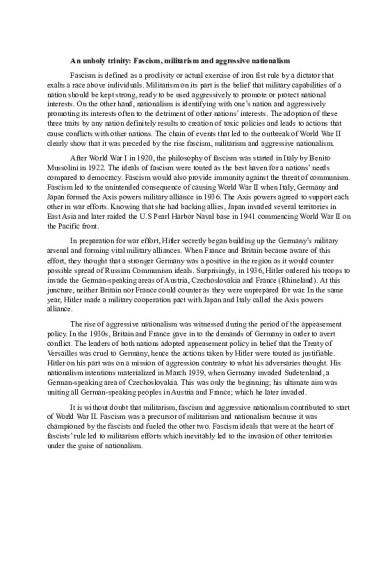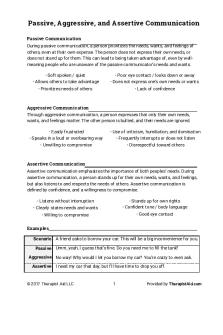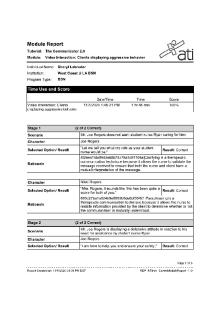An unholy trinity Fascism, militarism and aggressive nationalism PDF

| Title | An unholy trinity Fascism, militarism and aggressive nationalism |
|---|---|
| Author | Mutuma Gitonga |
| Course | American Polictics |
| Institution | Trinity University |
| Pages | 1 |
| File Size | 62.6 KB |
| File Type | |
| Total Downloads | 91 |
| Total Views | 164 |
Summary
Fascism is defined as a proclivity or actual exercise of iron fist rule by a dictator that exalts a race above individuals. Militarism on its part is the belief that military capabilities of a nation should be kept strong, ready to be used aggressively to promote or protect national interests. On th...
Description
An unholy trinity: Fascism, militarism and aggressive nationalism Fascism is defined as a proclivity or actual exercise of iron fist rule by a dictator that exalts a race above individuals. Militarism on its part is the belief that military capabilities of a nation should be kept strong, ready to be used aggressively to promote or protect national interests. On the other hand, nationalism is identifying with one’s nation and aggressively promoting its interests often to the detriment of other nations’ interests. The adoption of these three traits by any nation definitely results to creation of toxic policies and leads to actions that cause conflicts with other nations. The chain of events that led to the outbreak of World War II clearly show that it was preceded by the rise fascism, militarism and aggressive nationalism. After World War I in 1920, the philosophy of fascism was started in Italy by Benito Mussolini in 1922. The ideals of fascism were touted as the best haven for a nations’ needs compared to democracy. Fascism would also provide immunity against the threat of communism. Fascism led to the unintended consequence of causing World War II when Italy, Germany and Japan formed the Axis powers military alliance in 1936. The Axis powers agreed to support each other in war efforts. Knowing that she had backing allies, Japan invaded several territories in East Asia and later raided the U.S Pearl Harbor Naval base in 1941 commencing World War II on the Pacific front. In preparation for war effort, Hitler secretly began building up the Germany’s military arsenal and forming vital military alliances. When France and Britain became aware of this effort, they thought that a stronger Germany was a positive in the region as it would counter possible spread of Russian Communism ideals. Surprisingly, in 1936, Hitler ordered his troops to invade the German-speaking areas of Austria, Czechoslovakia and France (Rhineland). At this juncture, neither Britain nor France could counter as they were unprepared for war. In the same year, Hitler made a military cooperation pact with Japan and Italy called the Axis powers alliance. The rise of aggressive nationalism was witnessed during the period of the appeasement policy. In the 1930s, Britain and France gave in to the demands of Germany in order to avert conflict. The leaders of both nations adopted appeasement policy in belief that the Treaty of Versailles was cruel to Germany, hence the actions taken by Hitler were touted as justifiable. Hitler on his part was on a mission of aggression contrary to what his adversaries thought. His nationalism intentions materialized in March 1939, when Germany invaded Sudetenland, a German-speaking area of Czechoslovakia. This was only the beginning; his ultimate aim was uniting all German-speaking peoples in Austria and France; which he later invaded. It is without doubt that militarism, fascism and aggressive nationalism contributed to start of World War II. Fascism was a precursor of militarism and nationalism because it was championed by the fascists and fueled the other two. Fascism ideals that were at the heart of fascists’ rule led to militarism efforts which inevitably led to the invasion of other territories under the guise of nationalism....
Similar Free PDFs

Nationalism and Fascism
- 5 Pages

Fascism vs Nationalism
- 10 Pages

Fascism and Mussolini Worksheet
- 2 Pages

Nationalism and Patriotism
- 9 Pages

Nations and Nationalism - exam notes
- 29 Pages

American Freedom to fascism
- 1 Pages

European Fascism Notes
- 1 Pages

Nationalism summarised notes
- 7 Pages

Nationalism in the west
- 6 Pages

Basic Principles OF Fascism
- 5 Pages
Popular Institutions
- Tinajero National High School - Annex
- Politeknik Caltex Riau
- Yokohama City University
- SGT University
- University of Al-Qadisiyah
- Divine Word College of Vigan
- Techniek College Rotterdam
- Universidade de Santiago
- Universiti Teknologi MARA Cawangan Johor Kampus Pasir Gudang
- Poltekkes Kemenkes Yogyakarta
- Baguio City National High School
- Colegio san marcos
- preparatoria uno
- Centro de Bachillerato Tecnológico Industrial y de Servicios No. 107
- Dalian Maritime University
- Quang Trung Secondary School
- Colegio Tecnológico en Informática
- Corporación Regional de Educación Superior
- Grupo CEDVA
- Dar Al Uloom University
- Centro de Estudios Preuniversitarios de la Universidad Nacional de Ingeniería
- 上智大学
- Aakash International School, Nuna Majara
- San Felipe Neri Catholic School
- Kang Chiao International School - New Taipei City
- Misamis Occidental National High School
- Institución Educativa Escuela Normal Juan Ladrilleros
- Kolehiyo ng Pantukan
- Batanes State College
- Instituto Continental
- Sekolah Menengah Kejuruan Kesehatan Kaltara (Tarakan)
- Colegio de La Inmaculada Concepcion - Cebu





